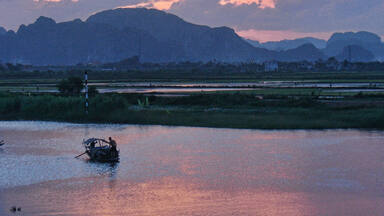Mount Hamiguitan Range Wildlife Sanctuary
Mount Hamiguitan Range Wildlife Sanctuary
Forming a mountain ridge running north-south along the Pujada Peninsula in the south-eastern part of the Eastern Mindanao Biodiversity Corridor, the Mount Hamiguitan Range Wildlife Sanctuary has an elevation range of 75–1,637 m above sea level and provides critical habitat for a range of plant and animal species. The property showcases terrestrial and aquatic habitats at different elevations, and includes threatened and endemic flora and fauna species, eight of which are found only at Mount Hamiguitan. These include critically endangered trees, plants and the iconic Philippine eagle and Philippine cockatoo.
Description is available under license CC-BY-SA IGO 3.0
Sanctuaire de faune et de flore sauvages de la chaîne du mont Hamiguitan
Formant une crête montagneuse de direction nord-sud le long de la péninsule de Pujada, dans la partie sud-est du corridor de biodiversité oriental de Mindanao, le sanctuaire de faune et de flore sauvages de la chaîne du mont Hamiguitan a une amplitude altitudinale de 75 à 1 637 m au-dessus du niveau de la mer et offre un habitat d’importance critique à toute une gamme d’espèces animales et végétales. Le bien présente des habitats terrestres et aquatiques à différentes élévations qui abritent des espèces endémiques de faune et de flore dont huit ne vivent que sur le mont Hamiguitan. Ces espèces comprennent des arbres et des plantes en danger critique et deux oiseaux emblématiques : l’aigle des Philippines et le cacatoès des Philippines.
Description is available under license CC-BY-SA IGO 3.0
Santuario de fauna y flora salvaje de la cadena del monte Hamiguitan
El sitio forma una cresta montañosa de norte a sur de la península de Pujada, en el sureste del corredor de biodiversidad oriental de Mindanao. La amplitud de sus alturas, que van de los 75 a los 1.637 metros sobre el nivel del mar, ofrece un hábitat excepcional terrestre y marino para numerosas especies de animales y plantas. El sitio alberga numerosas especies protegidas así como ocho especies endémicas de flora y fauna. Entre ellas figuran árboles y plantas en situación crítica y dos aves emblemáticas: el águila de Filipinas y la cacatúa de Filipinas.
source: UNESCO/CPE
Description is available under license CC-BY-SA IGO 3.0
ハミギタン山地野生生物保護区
source: NFUAJ
Wildreservaat Hamiguitan gebergte
Source: unesco.nl
Outstanding Universal Value
Brief synthesis
Forming a north-south running mountain ridge along the Pujada Peninsula in the southeastern part of the Eastern Mindanao Biodiversity Corridor, the Mount Hamiguitan Range Wildlife Sanctuary has an elevation range of 75-1,637 m above sea level, and provides critical habitat for a range of plant and animal species. The property showcases terrestrial and aquatic habitats and the species that they host at a series of different elevations are responding to highly dissimilar soil and climate conditions. The Mount Hamiguitan Range Wildlife Sanctuary provides a sanctuary to a host of globally threatened and endemic flora and fauna species, eight of which are found nowhere else except Mount Hamiguitan. These include critically endangered trees, plants and the iconic Philippine Eagle and Philippine Cockatoo.
Criterion (x): The Mount Hamiguitan Range Wildlife Sanctuary represents a complete, substantially intact and highly diverse mountain ecosystem, in a significant biogeographic region of the Philippines. Its diversity of plants and animals include globally threatened species as well as a large number of endemic species including those species that exist only in the Philippines, only in Mindanao and only in the nominated property. The fragile tropical “bonsai” forest that crowns the Mount Hamiguitan Range Wildlife Sanctuary epitomizes nature’s bid to survive in adverse conditions. As a result of its semi-isolation and its varied habitat types growing in dissimilar soil and climate conditions, its biodiversity has shown a significantly high level of endemicity that has led scientists to believe that there may be more globally unique species waiting to be discovered in the area.
The combination of terrestrial and aquatic ecosystems within the boundaries of the property and the large number of species inhabiting each makes the Mount Hamiguitan Range Wildlife Sanctuary home to a total of 1,380 species with 341 Philippine endemics that include critically endangered species such as the iconic Philippine Eagle (Pithecophaga jefferyi) and the Philippine Cockatoo (Cacatua haematuropygia), as well as the trees Shorea polysperma, Shorea astylosa, and the orchid Paphiopedilum adductum. Its high level of endemicity is well exemplified by the proportion of its amphibian (75% endemic) and reptile (84% endemic) species.
The Mount Hamiguitan Range Wildlife Sanctuary exhibits segmentation of terrestrial habitats according to elevation. In the lower elevations the agro-ecosystem and remnants of dipterocarp forests house some 246 plant species including significant numbers of endemics such as the globally threatened dipterocarps of the genus Shorea. The dipterocarp forest ecosystem at 420-920 m asl is characterized by the presence of large trees and is home to 418 plant and 146 animal species, which include threatened species such as the Mindanao Bleeding-heart dove (Gallicolumba crinigera) and Philippine warty pig (Sus philippensis). At higher elevations the montane forest ecosystem exhibits numerous species of mosses, lichens and epiphytes. This ecosystem type houses 105 animal species representing all the animal groups found in the Mount Hamiguitan Range Wildlife Sanctuary as well as the relatively recently discovered rat species, Hamiguitan hairy-tailed rat (Batomys hamiguitan). The fourth ecosystem type is the typical mossy forest ecosystem characterized by thick mosses covering roots and tree trunks; it provides habitat for the Philippine pygmy fruit bat, (Haplonycteris fischeri) and the threatened Pointed-snouted tree frog (Philautus acutirostris). At the topmost (1160-1200m a.s.l.) is the mossy-pygmy forest ecosystem, adding a unique natural tropical bonsai forest layer to the property. It is the only known habitat in the world of the pitcher plant (Nepenthes hamiguitanensis) and the Delias butterfly (Delias magsadana).
Integrity
The property is substantially intact and of adequate size to provide for the conservation of its biodiversity and other natural resources. It remains well preserved and intact as evidenced by the results of studies and ongoing monitoring. The Mount Hamiguitan Range Wildlife Sanctuary protects typical mountain ecosystems of the biogeographic region and include the agro-ecosystem, dipterocarp, montane, mossy, and mossy-pygmy forests. These ecosystems harbour an assemblage of endemic, rare and economically important flora and fauna. The level of vegetative cover indicates that the property is in relatively pristine condition with its surface area covered by a mix of closed and open canopy forest and smaller areas of brush land. The terrestrial and aquatic habitats are well preserved and a number of globally threatened and endemic species rely on or occur within the Mount Hamiguitan Range Wildlife Sanctuary. The Mount Hamiguitan Range Wildlife Sanctuary’s marked vertical zonation of vegetation and associated habitats makes it particularly vulnerable to climate change impact.
Protection and management requirements
The property straddles two municipalities and one city: San Isidro Municipality, Governor Generoso Municipality and the City of Mati, in the Province of Davao Oriental, and totals an area of 16,923 ha with a buffer zone of 9,729 ha. The Mount Hamiguitan Range Wildlife Sanctuary is protected through several protected area regulations and is a component of the Philippines’ National Integrated Protected Areas System (NIPAS). Several layers of national and provincial legislation and policies serve to protect the property and guide management. Apart from delineating the boundaries of the property, these laws prohibit incompatible activities such as logging, mining, exploration or surveying for energy resources inside the property. Responsibility for enforcement is shared by both the national and local government agencies in partnership with other stakeholders.
The protection of the Mount Hamiguitan Range Wildlife Sanctuary is further strengthened by the engagement with and involvement of local and indigenous communities living in its periphery in the management of the property. Their lifestyles and spiritual beliefs are based on respect for the environment and its biodiversity and they have, over time, subtly molded their way of life to ensure the sustainable use of their resources. At the same time, the harsh conditions of the mountain range serve as a deterrent for other human settlements that do not conform to a similarly symbiotic lifestyle. Threats in and around the property include illegal collection of wildlife, mining, development pressures, potential pressures and impacts from tourism and climate change. Management authorities have implemented a monitoring and research programme to anticipate climate change effects on the biota and try to mitigate consequent impacts. Ongoing monitoring will be needed to predict and respond to such impacts.
The Mount Hamiguitan Protected Area Management Board (PAMB) overses protection and management of the property according to the approved Mount Hamiguitan Range Wildlife Sanctuary Management Plan of 2011. The Protected Area Superintendents Office (PASO) implements the activities set down in the plan as well as the policies and directives issued by the PAMB. Together with the “Bantay Gubat” personnel from the three municipalities with territorial jurisdiction over the nominated property, the PASO conducts regular monitoring and patrol activities over the core and buffer zones. A five year visitor and tourism management plan is in place to ensure the effective management of use, and should be kept updated. The municipalities overlapping the property have aligned their tourism and development plans to the Management Plan of the Mount Hamiguitan Range Wildlife Sanctuary, helping to ensure that the importance of protection of the property will be given the necessary recognition and consideration and that development will not hamper or detract from the conservation and protection of the biodiversity of the Mount Hamiguitan Range Wildlife Sanctuary.


